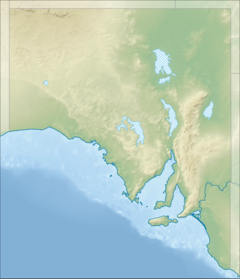Lincoln National Park
| Lincoln National Park | ||
|---|---|---|
| Panorama of the Proper Bay | ||
|
|
||
| Location: | South Australia , Australia | |
| Specialty: | Eucalyptus and acacia forests, coastal landscape, South Australia's first national park | |
| Next city: | Port Lincoln | |
| Surface: | 315 km² | |
| Founding: | 1941 | |
The 315 km² Lincoln National Park is located in the state of South Australia in Australia , 15 kilometers south of Port Lincoln and 249 kilometers west of Adelaide on the Eyre Peninsula . When the park was established in 1941, it was the first national park in South Australia. It comprises a peninsula on the southern tip of the Eyre Peninsula and some islands in front of it.
history
The Aboriginesstämme the Barngala and Nauo lived in this region before the European settlers arrived. The Europeans practiced timber, grazing and guano mining . The park offers a glimpse into the past times of European settlement as well as the aboriginal holy place along the Investigator Trail . Matthew Flinders was the first European to visit the area in 1802 and eight of his men were killed on an expedition to the sea. After this experience, he named the site of the accident Cape Catastrophe and its offshore islands after the eight people who had died: Thistle, Taylor , Smith, Little, Grindal, Hopkins, Williams and Lewis Islands.
fauna and Flora
From May to October whales can be seen coming from Antarctica to calve in the warmer waters around the park. Sea lions and dolphins swim near Cape Donigton and also at Curta Rocks. Numerous animals live in the park, such as gray kangaroos , Australian bush rats , dormouse butcher , rabbit- nosed fishers , derby wallabies and brushless kusu . 123 species of birds, including white- tailed eagles , parrots and an emuart that is unique to this area , geckos , reptiles and snakes are also found in the national park.
A wide variety of eucalyptus trees and bushes grow in the park . Acacias and wildflowers bloom in spring.
Visitor facilities
Camping, hiking, boating and picnicking are all possible. Fish can also be fished on the coast. Entering the park is only permitted with permission from the Port Lincoln Visitor Information Center .
